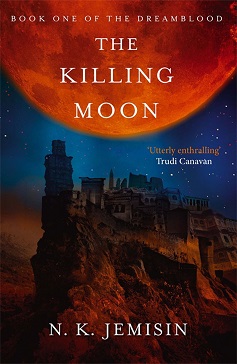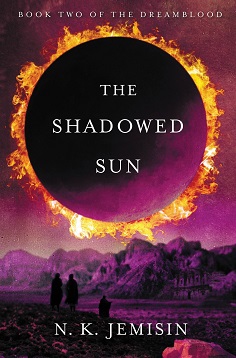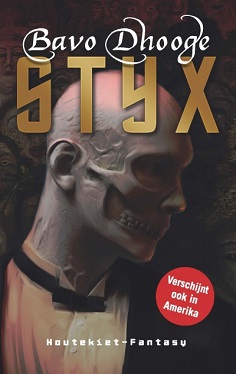
The Killing Moon & The Shadowed Sun
N. K. Jemisin
415/504 pages
published in 2012
Have you ever reached that point where you’ve read twothirds of a fantasy trilogy, quite like the writer but don’t want to read the last novel because it would mean rereading the first two? Yeah, that happened to me with N. K. Jemisin’s The Inheritance Trilogy, so instead I read her new series, The Dreamblood duology. Both The Killing Moon and The Shadowed Sun were published in 2012 and can be read as standalones, though you’ll miss a lot of the background if you only read The Shadowed Sun.
One of my ongoing frustrations with fantasy in general is how few novels take their inspiration from anything but medieval Europe. Medievaloid worlds as filtered through Tolkien and his imitators — where you can find pipe smoking peasants eating potoes with their turkey but few people of colour –are a dime a dozen, but books with Egypt as a source of worldbuilding are rare. In fact, The Dreamblood duology is the first series I can remember reading with Egypt as the inspiration for its setting, polytheism, annual flooding river surrounded by desert, powersharing between the priesthood and nominal god-king and all. What’s more, Jemisin was also inspired by Egypt’s historical relationship with Kush, the kingdom to the south of it in what’s now Sudan, who shared its culture and at times actually ruled it. In short, this is one fantasy in which pale Northern European heroes are in short supply.
Of course whenever any author moves out of the ruts of medievaloid fantasy they run the risk of cultural appropriation, of exchanging one set of cliches for another. Which may be why Jemisin is at pains in her foreword to establish that while she was inspired by Egypt and Kush, Gujaareh and Kisua aren’t meant to be exact mirrors of them. Certainly the religious setup, while superficially reminiscent of ancient Egypt, doesn’t look anything like the real Egyptian pantheon.
Instead the religion in the city state of Gujaareh revolves around moon goddes worship, of Hananja, the Goddess of the Dreaming Moon, much larger than its companion the Waking Moon and whose description makes clear that the Dreaming Moon is actually a gas giant around which the world revolves. No wonder than that it plays such a large role in Gujaareh religion, with Hananja’s priests, the Hetawa, ruling the city state in tandem with its prince. They’re responsible for public justice as well as public health, using dream magic tithed from the city’s population, magic that comes in different flavours as dreams come in different flavours and is cared for and used by seperate classes of priests.
And the most elite class of priests are the Gatherers, the priests who gather those too sick or old or selfish to seek the peace of the goddess on their own. Instead Gatherers like Ehiru visit these people in their homes, bringing the peace of the Goddess to them. All voluntarily done of course, with the exception of those found to be corrupt.
For Nijiri, recently apprenticed to Ehiru to learn to become a Gatherer, this is right and proper. Gatherers serve the Goddess just as Sentinels and Sharers and all the other priests and priestesses do and some would say theirs was the noblest path, bringing peace to those who suffer. The Kisuati envoy Sunandi is more cynical; in Kisua all these magics are suspect and the Gatherers look like just a thin excuse to murder enemies of the Goddess. And now that her old mentor has been murdered for discovering proof of the use of magic even the priests of Gujareeh find an abomination, she’s afraid that sooner or later the Gatherers will find her corrupt.
There is in fact corruption, but not in her. Rather, a parody of a Gatherer is loose, a demon that seeks dreamblood of anybody it comes across. What’s worse is the reason it exists: somebody deliberately set it loose on Gujareeh and is protecting it. To what end, Ehiru and his assistent Nijiri undertake to find out before whoever is behind the demon achieves it. Sunandi is doing the same from her end and of course she and Ehiru meet and come to a grudging respect, having to work together to end the threat to both their countries.
The plot was gripping enough to keep me awake during the daily commute in the darkest days of January, but it’s the world building that’s the real star of this novel. It’s not just the Egyptian inspired society of Gujareeh, but the fact that it isn’t populated with just more white people. Jemisin is a writer with things to say about race and gender and she’s great in doing so in a way that it doesn’t become didactic.

The Shadowed Sun takes place ten years after The Killing Moon, at the end of which Gujareeh has been put under a Kisuati Protectorate. That had been the only way to contain and destroy the evil taking place in the city state, to prevent it from spreading abroad. Now however the inhabitants are suffering under the Kisuati yoke, no matter how light, especially in the disrespect directed to the priesthood. Sunandi, now the Voice of the Protectorate in Gujareeh knows better than most Kisuati the bond between the citizens and their priests and she does her best to keep provocations at a minimum. Nijiri meanwhile, grown out of Ehiru’s shadow and a full grown Gatherer, knows this is not enough and things need to change again.
Change is coming internally, in the form of Hanani, the first female apprentice to the Sharers, the healers amongst the priests of Hananja. This is change that’s not everywhere received well, as the Gujareeh people believing very much in different roles for men and women, with the latter being goddesses that should be revered at home. Which is very much the usual sort of bullshit propagated by, well, men, something also noted by Sunandi in The Killing Moon.
Change is also coming from outside, in the form of Wanahomen, the heir to Gujareeh’s prince, who died in the previous book. Afther the Kisuati invasion Wanahomen’s mother fled to the barbarian desert tribes that had always been a thorn in the side of Gujareeh and now Wanahomen hopes to use them to overthrow the Kisuati Protectorate.
Meanwhile another dream evil is stalking the streets of the city states, but whereas in the first book it had been a nightmare made flesh, this time it is an epidemic of fatal nightmares. Once again dream magic is used for political gain without thoughts for the consequences of such use.
With The Shadowed Sun Jemisin managed to produce a sequel that follows on logically from the previous book without being more of the same. She manages to explore Gujareeh’s society and its attitudes to gender relations more without using strawmen or having it be extraordinarily similar to our own. What I liked especially was how both Gujareeh and Kisua have more and less “progressive” aspects to their respective societies, in ways that made sense.
To conclude then, this duology was one of the better fantasy series I’ve read in the last couple of years, an improvement on Jemisin’s already impressive writing in her first series.


